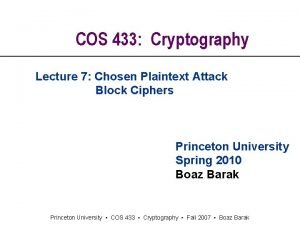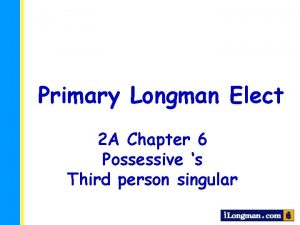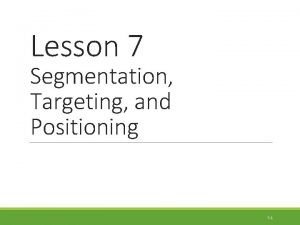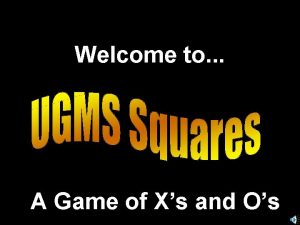Document that explains the chosen concept to the































- Slides: 31

Document that explains the chosen concept to the animator 1

Intrinsic Semiconductors Any chemically pure semiconductor has properties which are characteristic of the material alone. Such a material is called an “intrinsic semiconductor. ”In the intrinsic case, conduction band electrons can only have come from formerly occupied valence band levels, leaving holes behind them. Course Name: Semiconducting Properties of materials. Authors Anura. B. Kenkre 2

Learning Objectives After interacting with this Learning Object, the learner will be able to: • Define an intrinsic semiconductor. • Predict the effect of an increase in temperature on the current flowing through the circuit. 3

1 Definitions of the components/Keywords: • Any chemically pure semiconductor has properties which are characteristic of the material alone. Such a material is called an “intrinsic semiconductor. ” 2 3 4 5 4

IMPORTANT NOTE TO THE ANIMATOR: • All the instructions/labels or anything WRITTEN in blue are CONTENT NOT TO BE DISPLAYED! • All the instructions WRITTEN in black are CONTENT TO BE DISPLAYED! • This is not applicable for images as there can be overlapping of these colours there. This should be followed for all the instructions, labels, etc… Kindly keep a note of this while displaying text in the animation. 5

INSTRUCTIONS SLIDE 1 2 Master layout or diagram • Make a schematic diagram of the concept • Explain to the animator about the beginning and ending of the process. • Draw image big enough for explaining. 3 4 5 • In above image, identify and label different components of the process/phenomenon. (These are like characters in a film) • Illustrate the basic flow of action by using arrows. Use BOLD lines in the diagram, (minimum 2 pts. ) • In the slide after that, provide the definitions of ALL the labels used in the diagram 6

INSTRUCTIONS SLIDE 1 2 3 4 5 Master layout or diagram • You may have multiple master layouts. – In this case, number the master layout. ( e. g. Master layout 1) – Each Master layout should be followed by the stepwise description of the animation stages related to it. 7

Master Layout 1 This is called the microscopic picture These are the names given to the violet and gray rectangles. electrons Ge Ge Ge INTERACTIVITY: thermometer Ge Conduction band Eg Ge Ge T 2=500 K (~much above room temperature) Valence band T 1=300 K Ge Ge Ge 3 5 Ge This image is called the energy band diagram. Use this font for the display. this is the LED display for the ammeter. Fig 1 4 (room Temperature) Ge Germanium crystal Fig 2 Radio buttons m. A ammeter 1. 5 V battery Fig 3 This is called the circuit. T=0 K (Absolute zero) Temperature options 8

1 2 3 4 5 Animation design • Please see the design template provided in the next slide. • This is a sample template, and you are free to change as per your design requirements. • Try and recreate the sections/subsections as shown in the template. 9

What will you learn Lets Learn! Definitions Test your understanding (questionnaire) Microscopic view Lets Sum up (summary) Credits Want to know more… (Further Reading) Energy band diagram Conduction band Ge Ge Ge Eg Ge Ge Valence band T 2=500 K (~much above room temperature) T 1=300 K (room Temperature) Ge Circuit T=0 K (Absolute zero) Ge m. A 1. 5 V 10

1 2 3 Explain the process 4 5 In this step, use an example to explain the concept. It can be an analogy, a scenario, or an action which explains this concept/process/topic Try to use examples from day-to-day life to make it more clear You have to describe what steps the animator should take to make your concept come alive as a series of moving images. Keep the examples simple to understand, and also to illustrate/animate. 11

1 Stepwise description of process 2 3 4 5 The goal of the document is to provide instructions to an animator who is not a expert. You have to describe what steps the animator should take to make your concept come alive as a moving visualization. Use one slide per step. This will ensure clarity of the explanation. Add a image of the step in the box, and the details in the table below the box. You can use any images for reference, but mention about it's copyright status The animator will have to re-draw / re-create the drawings Add more slides as per the requirement of the animation 12

1 Step 1: Select a temperature Refer to the master layout for the interactivity…given below are samples depicting the radio buttons just for your reference. T=0 K 2 3 4 5 Interactivity type (IO 1/IO 2. . ) • Radio buttons Instruction to the learner • Select a temperature T 1=300 K Instructions for the animator • Show a pop up near thermometer asking the user to select a temperature. • Depending upon the radio button selected go to slide 14, 16 and 18 respectively. T 2=500 K Results and Output • If the user selects T=0, go to slide 14. • If the user selects T 1=300 K go to slide 16. • If the user selects T 2=500 K go to slide 18. 13

For the germanium crystal, give a mouse over of the following: Length=1 cm Width=1 mm Thickness=1 mm Notice that the units are milliamperes (m. A) Microscopic view Covalent bonds Valence band Energy band diagram Circuit Display 0. 00 here Conduction band electrons Ge Ge E M P T Y m. A Eg Ge Valence band Ge Ge 1. 5 V Valence band Redraw all the images. . do not retain the company names, if any. . Fill up this gray rectangle with the gray balls…The number of balls shown here need not be followed…and show the same effect as indicated for all of them…make sure that the labels of ‘valence band conduction band do not overlap on the electrons. The total number of balls in this rectangle has to be same in slides 14, 16 and 18. 14

1 Step 2: Absolute zero Refer to images on slide 14. 2 3 4 5 Description of the action/ interactivity • Show the animation as shown on slide 14. • Repeat the animation till the user selects another temperature. Audio Narration (if any) • At absolute zero temperatures, all valence electrons are tightly held by the silicon atoms because they are part of the covalent bonds between the atoms. • Since the conduction band is empty, no current can exist in the silicon crystal. 15

Thermal energy Note: the motion of electrons in Fig 1 and 2 should happen simultaneously. . (It could happen a little late here due to limitations of powerpoint) Notice that the units are milliamperes (m. A) Display 3. 3 here n ba uc tio n tio uc nb nd an d Co For the germanium crystal, give a mouse over of the following: Length=1 cm Width=1 mm Thickness=1 mm Co d nd Valence band Conduction band hole Ge Ge electron Ge Ge hole Ge m. A Eg Ge Valence band Ge Ge 1. 5 V Ge Co n Ge electron hole uc t d electron n io Valence band electron tio n nd ba hole Fig 2 du c n Co Fig 1 Redraw all the images. . do not retain the company names, if any. . hole electron hole Fig 3 Fill up this gray rectangle with the gray balls…The number of balls shown here need not be followed…and show the effect as indicated for only those gray balls that are shown here. . NOT FOR ALL OF THEM. . make sure that the labels of ‘valence band conduction band do not overlap on the electrons. The total number of balls in this rectangle has to be same in slides 14, 16 and 18. 16 ba nd

1 Step 3: Room temperature Refer to images on slide 16. 2 3 4 5 Description of the action/ interactivity • Show the animation as shown on slide 16. • And while you are showing the animation in Fig 1 and 2, display the reading in Fig 3 simultaneously. • Also, Include a minus sign on the electrons. It is not included here due to space constraints. • Repeat the animation till the user selects another temperature. Audio Narration (if any) • Above absolute zero, the incoming heat energy breaks some covalent bonds. • Due to this, we get a limited number of conduction band electrons as heat energy has lifted some electrons into the conduction band. • Each time an electron goes to the conduction band, it leaves behind a vacancy which is called a hole. 17

Thermal energy Note: the motion of electrons in Fig 1 and 2 should happen simultaneously. . (It could happen a little late here due to limitations of powerpoint) nd Co Valence band hole electron Ge Ge hole Ge electron hole Ge Ge Notice that the units are Amperes(A) Display 1. 84 here nd ba uc tio n tio uc nb nd an d Co For the germanium crystal, give a mouse over of the following: Length=1 cm Width=1 mm Thickness=1 mm Conduction band Ge Ge A Eg electron Gehole Valence band Ge 1. 5 V Ge Co n Ge electron uc t d hole io n n io Valence band electron hole nd ba uc t nd Co Fig 1 Redraw all the images. . do not retain the company names, if any. . Fig 2 electron holeelectron hole Fig 3 Fill up this gray rectangle with the gray balls…The number of balls shown here need not be followed…and show the effect as indicated for only those gray balls that are shown here. . NOT FOR ALL OF THEM. . make sure that the labels of ‘valence band conduction band do not overlap on the electrons. The total number of balls in this rectangle has to be same in slides 14, 16 and 18. 18 ba nd

1 Step 9: much above room temperature. Refer to images on slide 18. 2 3 4 5 Description of the action/ interactivity • Show the animation as shown on slide 18. • And while you are showing the animation in Fig 1 and 2, display the reading in Fig 3 simultaneously • Also, Include a minus sign on the electrons. It is not included here due to space constraints. • Repeat the animation till the user selects another temperature. Audio Narration (if any) • As the tempearture increases, the resistivity of the semiconductor goes on decreasing. • Thus, the semiconductor offers a negative tempearture coefficient of resistance. 19

1 Interactivity and Boundary limits 2 3 4 5 In this section, you will add the ‘Interactivity’ options to the animation. Use the template in the next slide to give the details. Insert the image of the step/s (explained earlier in the Section 3) in the box, and provide the details in the table below. The details of Interactivity could be: Types: Drop down, Slider bar, Data inputs etc. Options: Select one, Multiple selections etc Boundary Limits: Values of the parameters, which won’t show results after a particular point Results: Explain the effect of the interaction in this column Add more slides if necessary 20

1 Interactivity option 1: Step No: 2 3 Refer to slides 13 to 19. Interactivity type (IO 1/IO 2. . ) Instruction to the learner Boundary limits Instructions for the animator Results and Output 4 5 21

INSTRUCTIONS SLIDE Self- Assessment Questionnaire for Learners • Please provide a set of questions that a user can answer based on the LO. They can be of the following types: – These questions should be 5 in number and can be of objective type (like MCQ, Match the columns, Yes or No, Sequencing, Odd One Out). – The questions can also be open-ended. The user would be asked to think about the question. The author is requested to provide hints if possible, but a full answer is not necessary. – One can include questions, for which the user will need to interact with the LO (with certain parameters) in order to answer it. 22

INSTRUCTIONS SLIDE Questionnaire for users to test their understanding • Please make sure that the questions can be answered by interacting with the LO. It is better to avoid questions based purely on recall. 23

Questionnaire 1. What is the difference in the energy band diagrams for room temperature and at a temperature much above room temperature? Answers: a) At room temperature, lesser number of electrons are excited to the conduction band as compared to much above room temperature b) At room temperature, more number of electrons are excited to the conduction band as compared to much above room temperature c) there is no difference in diagrams at different temperatures d)electrons are not excited to the conduction band at room temperature but they start getting excited at temperatures much above room temperature. Answers: 1) a Feedback: If user clicks correct answer then display “Correct! Make sure you can explain the reasoning!” If user clicks incorrect answer then display “Have a look at the simulation and Try again!” 24

Questionnaire 2. Why is there more current at higher temperatures? Answers: a) more number of electrons in the valence band b)lesser number of electrons getting excited from the valence band to the conduction band c) more number of electrons getting excited from the valence band to the conduction band d) cannot say. Answers: 2) c Feedback: If user clicks correct answer then display “Correct! Make sure you can explain the reasoning!” If user clicks incorrect answer then display “Have a look at the simulation and Try again!” 25

Questionnaire 3. The fact there are more number of electrons in the conduction band at higher temperatures is due to which of the following reasons? Answers: a) the crystal contains more number of electrons at higher temperatures b) as the temperature is raised, there exists more energy which causes more number of electrons to get excited c) Both a and b. d) At higher temperatures, there exist collisions between the electrons, which causes more number of electrons to get excited to the conduction band. Answers: 3) b Feedback: If user clicks correct answer then display “Correct! Make sure you can explain the reasoning!” If user clicks incorrect answer then display “Have a look at the simulation and Try again!” 26

Questionnaire 4. Why are Si and Ge called ‘INTRINSIC’ Semiconductors? ? Answers: a) Since they conduct electricity at room temperatures b) Since they do not conduct electricity at absolute zero c) Both a and b. d) Since they are chemically pure and have properties which are characteristic of the material alone. Answers: 4)d Feedback: If user clicks correct answer then display “Correct! Make sure you can explain the reasoning!” If user clicks incorrect answer then display “Have a look at the simulation and Try again!” 27

Open ended questions: 1. What happens when more number of electrons are excited from the valence band to the conduction band at higher temperatures? 2. What do think happens to the electrons and holes in the valence band once any electron gets excited from the valence band to the conduction band? ? (Hint 1: Watch the animation on ‘Conductivity in Intrinsic Semiconductors’ to get an idea… Hint 2: Watch the animation on Hole current to get an idea…) (Note to the animator: Show hint 1 for question 1 and hint 2 for question 2. Show these as clickable buttons next to the question so that when the user clicks on it, she will be able to view it. . )This note is for the reference of the animator and it is not to be shown on screen. 28

Links for further reading Books: 1)Solid state physics-MA Wahab. (chapter 13) 2)Solid state physics-Ashcroft/Mermin. (Chapter 28) 3)Introduction to modern physics. Richtmyer, Kennard, Cooper. (Chapter 23) 29

INSTRUCTIONS SLIDE Summary • Please provide points to remember to understand the concept/ key terms of the animation • The summary will help the user in the quick review of the concept. 30

Summary • • Any chemically pure semiconductor has properties which are characteristic of the material alone. Such a material is called an “intrinsic semiconductor. ” More number of electrons get excited to the conduction band at higher temperatures and hence more current flows through the circuit. 31
 Chosen concept
Chosen concept Con hãy đưa tay khi thấy người vấp ngã
Con hãy đưa tay khi thấy người vấp ngã Thơ thất ngôn tứ tuyệt đường luật
Thơ thất ngôn tứ tuyệt đường luật Tôn thất thuyết là ai
Tôn thất thuyết là ai Phân độ lown
Phân độ lown Walmart thất bại ở nhật
Walmart thất bại ở nhật Gây tê cơ vuông thắt lưng
Gây tê cơ vuông thắt lưng Premature atrial contraction
Premature atrial contraction Tìm độ lớn thật của tam giác abc
Tìm độ lớn thật của tam giác abc Sau thất bại ở hồ điển triệt
Sau thất bại ở hồ điển triệt Thể thơ truyền thống
Thể thơ truyền thống Document.cookie
Document.cookie Concept document for project
Concept document for project Game concept paper
Game concept paper Spacebar
Spacebar High concept game
High concept game High concept game design
High concept game design A sample poll of 100 voters chosen at random
A sample poll of 100 voters chosen at random Apikorsim meaning
Apikorsim meaning Social identity map template
Social identity map template The freely chosen activity between buyers and sellers
The freely chosen activity between buyers and sellers Q: in datagram subnet new route is chosen
Q: in datagram subnet new route is chosen Chosen-plaintext attack
Chosen-plaintext attack It is not you they are rejecting but me
It is not you they are rejecting but me Longman elect 2a
Longman elect 2a May you be happy in the life you have chosen
May you be happy in the life you have chosen Https://www.census.gov/popclock/
Https://www.census.gov/popclock/ Yazoo land fraud definition
Yazoo land fraud definition The topic i have chosen
The topic i have chosen If a vertical rectangular strip is chosen
If a vertical rectangular strip is chosen The chosen written by
The chosen written by The chosen chapter 7
The chosen chapter 7






















































